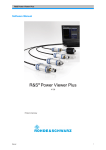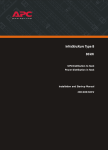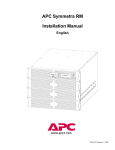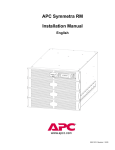Download APC AP9830 Operating instructions
Transcript
Remote Power-Off Device AP9830 Thank You! Thank you for selecting the Remote Power-Off Device (AP9830). It has been designed for many years of reliable, maintenance-free service in combination with your American Power Conversion (APC) uninterruptible power supply (UPS). APC is dedicated to the development of high-performance electrical power conversion and control products. We hope that you will find this product a valuable, convenient addition to your computing system. Please read this manual! It provides important safety, installation, and operating instructions that will help you get the most from your Remote Power-Off Device. Save this manual! It includes instructions for obtaining warranty service. Contents Overview . . . . . . . . . . . . . . . . . . . . . . . . . . . . . . . . . . . . . . . 1 Introduction 1 Features of the Remote Power-Off Device 1 Hardware requirements 2 Safety warning 2 Inventory . . . . . . . . . . . . . . . . . . . . . . . . . . . . . . . . . . . . . . . 3 Inventory 3 Server-side view of the Remote Power-Off unit 4 UPS-side view of the Remote Power-Off unit 5 Top view of the Remote Power-Off unit 5 Configuration . . . . . . . . . . . . . . . . . . . . . . . . . . . . . . . . . . . . 6 Overview of Configuration and Setup 6 Configuring the device 6 Power-off condition—DIP switches #1 & #2 7 Power-off mode—DIP switch #3 8 DIP switch #4 8 Setup . . . . . . . . . . . . . . . . . . . . . . . . . . . . . . . . . . . . . . . . . . 9 Introduction 9 Connecting the Remote Power-Off Device 9 Switch types 10 Keystone jack PIN locations 10 RJ11 connector PIN locations 11 Connecting to the keystone jack 11 Placement of accessories 12 Warning 12 Continued on next page i Contents, continued Multiple UPS-Output Turnoff . . . . . . . . . . . . . . . . . . . . . . . . . 13 Introduction 13 Cascading multiple devices (serial setup) 13 Cascading with Matrix-UPS™ 14 Parallel setup (voltage input switches only) 14 No parallel setup for contact closure switches 15 Specifications . . . . . . . . . . . . . . . . . . . . . . . . . . . . . . . . . . . . 16 Remote switch requirements 16 Cable requirements 16 Warning 16 Product specifications 17 Ordering additional components 17 ii Overview Introduction American Power Conversion’s Remote Power-Off Device (AP9830) is an accessory that allows you to turn off the output of an APC™ uninterruptible power supply ( UPS) by a remote switch. In many facilities the UPS is not readily accessible. With the Remote Power-Off Device, you can immediately turn off the UPS output with a switch you have placed in a convenient location. For remote turnoff of more than one UPS by a single switch, you can set up each UPS with its own Remote Power-Off Device. For further information, see “Multiple UPS-Output Turnoff” on page 13. Features of the Remote Power-Off Device The Remote Power-Off Device: • Provides instantaneous remote turnoff of APC UPS output • Works with a variety of switches—normally open, normally closed, and applied voltage • Can be set up for shutting down multiple UPSs with one switch (one Remote Power-Off Device for each UPS) • Supports all functions normally available to the UPS, including the powering of accessories, smart signaling, and UPS Turn-on/Turn-off i Continued on next page 1 Overview continued Hardware requirements The Remote Power-Off Device requires: Safety warning Wiring safety is the responsibility of those installing the cable and remote switch. Incorrect installation can result in improper functioning of the device or damage to hardware. The use of substandard cables can produce toxic fumes in the event of a fire. 2 • An APC Smart-UPS®, Matrix-UPS™ or the Symmetra™ PowerArray™ • A switch (SELV or Class 2 circuit). See “Switch types: Table 4” on page 10. • A cable for connecting the remote switch to the Remote Power-Off Device. See “Cable requirements” on page 16. Inventory Inventory: Table 1 The Remote Power-Off Device consists of the parts listed in the following table. Item Illustration DB9-DB9 Cable (APC part number 940-0064) RJ11 Cable, 10 ft (607-0035) RJ11 Cable, 6 in. (607-0036) Table 1: Inventory Continued on next page 3 Inventory continued Inventory: Table 1 continued Item Illustration Remote Power-Off Unit FF R-OEST WE / T PO N S UP TO TIO RA IGU NF CO w ww .a c. co m E VIC E FD -OF 0 983 ER APPOW TE MO E SR UP pc CA O/ SC E AD T U EO AD SC CA IN RP OR ER IES RV OR SEESS C TO AC Keystone Jack (750-0023) Velcro® strip for optional mounting of the Remote Power-Off unit. Server-side view of the Remote Power-Off unit: Figure 1 The following figure shows the side of the Remote PowerOff unit that connects to the server or accessories. Figure 1:Server-side view of the Remote Power-Off unit Continued on next page 4 Inventory continued UPS-side view of the Remote Power-Off unit: Figure 2 The following figure shows the side of the Remote PowerOff unit that connects to the UPS. 1 2 3 4 Configuration DIP Switches DB9 Male Port – To UPS Figure 2:UPS-side view of the Remote Power-Off unit Top view of the Remote PowerOff unit: Figure 3 The top of the Remote Power-Off unit is shown in the following figure. The labels on the decal identify the components on the sides of the unit. LED CONFIGURATION TO UPS POWER-OFF / TEST w w w. a p c c . c o m AP9830 UPS REMOTE POWER-OFF DEVICE TO SERVER OR ACCESSORIES RPO / CASCADE IN CASCADE OUT Figure 3:Top view of the Remote Power-Off unit 5 Configuration Overview of Configuration and Setup To install the Remote Power-Off Device, follow these steps: Configuring the device To configure the device, set the DIP switches labeled “CONFIGURATION” on the Remote Power-Off Device. Refer to the rest of this section for specific information on DIP switches. 1 Configure the device to operate in Test (Disabled) power-off mode. 2 Connect the device according to “Setup” on page 9. 3 Test the device. 4 Configure the device to operate in the Enabled power-off mode. Continued on next page 6 Configuration continued Power-off condition — DIP switches #1 & #2: Table 2 DIP switches 1 and 2 govern the power-off condition for the Remote Power-Off Device. Refer to the table below to set DIP switches 1 and 2. Note: A contact closure switch toggles between an open and closed circuit. A voltage input switch applies and removes a voltage signal. For requirements, see “Switch types: Table 4” on page 10. Position† Switch Type Contact Closure (PINs 2, 5) Voltage Input (PINs 3, 4) DIP #1 DIP #2 A normally closed (N.C.) contact closure opens 24V is removed from the voltage input 1 0 A normally open (N.O.) contact closure closes 24V is applied to the voltage input 0 1 0 0 INVALID INVALID 1 1 Table 2: Power-off condition — DIP switches #1 & #2 † 0 = ↑, 1 = ↓ Continued on next page 7 Configuration continued Power-off mode — DIP switch #3: Table 3 DIP switch 3 governs the power-off mode for Remote Power-Off Device operation. Refer to the following table for a description of the power-off modes. Power-Off Mode Position† Purpose Test (Disabled) 0 Check wiring between the remote switch and the Remote Power-Off Device Enabled 1 Normal operation Table 3: Power-off mode — DIP switch #3 Power-Off Asserted No Yes † 0 = ↑, 1 = ↓ In either power-off mode, the Remote Power-Off Device LED appears lit when the device is properly connected and configured and the remote switch is being asserted. DIP Switch #4 8 DIP switch #4 is unassigned. Setup Introduction This section shows how to connect the Remote Power-Off Device. After setup, continue with the procedure in “Overview of Configuration and Setup” on page 6. If you are setting up multiple Remote Power-Off Devices for use with one remote switch, refer to this section for basic information on wiring and see “Multiple UPS-Output Turnoff” on page 13. Connecting the Remote PowerOff Device: Figure 4 Follow the figure below to set up the Remote Power-Off Device. Note that the RJ11 cable connects to the middle port of the unit, which is labeled “RPO / Cascade In.” Server To Remote Switch APC UPS Cable Supplied with Remote Power-Off Device Keystone Jack Remote Power-Off Unit RJ11 Cable Cable Supplied with PowerChute Software Figure 4:Connecting the Remote Power-Off Device Continued on next page 9 Setup continued Switch types: Table 4 The requirements and PIN assignments for the remote switch vary according to the type of switch being used: Requirements Contact Closure • Safety Extra Low Voltage (SELV) or Class 2 circuit • Switch or relay properly isolated from the utility • Latching Voltage Input 2, 5 • SELV or Class 2 circuit • Switched 24V AC/DC • Latching Table 4: Switch types Keystone jack PIN locations: Figure 5 RPO/Cascade In PIN Assignment Type 3, 4 The PIN locations for the keystone jack appear in the figure below. Figure 5:keystone jack PIN locations Continued on next page 10 Setup continued RJ11 connector PIN locations: Figure 6 The PIN locations for the RJ11 connector appear in the figure below. Figure 6:RJ11 connector PIN locations Connecting to the keystone jack: Table 5 The following table shows how to connect the switch cable wires (26–22 AWG required) to the keystone jack. Step Action 1 Place the individual wires (unstripped) over the cylinders associated with the wiring scheme you are using (contact closure scheme shown). For further information, see “Switch types: Table 4” on page 10. 2 Press down the clear plastic top of the jack so that the wires become wedged in the cylinder slits. The top should click into place. Figure Table 5: Connecting to the keystone jack Figure 7:Connecting to the keystone jack Continued on next page 11 Setup continued Placement of accessories The Remote Power-Off Device works effectively with all APC accessories, provided that the accessory is connected to the Remote Power-Off Device through the DB9 port labeled “TO SERVER OR ACCESSORIES.” Warning Do not connect any external APC UPS accessory between the Remote Power-Off Device and the UPS. An accessory connected between the Remote Power-Off Device and the UPS may be able to turn on the UPS during a remote poweroff condition. 12 Multiple UPS-Output Turnoff Introduction To set up the remote turnoff of more than one APC UPS with one switch, you must have one Remote Power-Off Device for each UPS. There are two types of setup for remote turnoff of multiple UPS outputs: • Cascading (serial) • Parallel (for voltage input switches only) Cascading multiple devices (serial setup): Figure 8 To set up either type of remote switch (contact closure or voltage input) by cascading Remote Power-Off Devices, refer to the figure below. UPS1 To Remote Switch UPS2 UPSn TO UPS TO UPS TO UPS CONFIGURATION CONFIGURATION CONFIGURATION w w w. a p c c . c o m RPO / CASCADE IN POWER-OFF / TEST POWER-OFF / TEST POWER-OFF / TEST w w w. a p c c . c o w w w. a p c c . c o m TO SERVER OR ACCESSORIES RPO / CASCADE IN m AP9830 UPS REMOTE POWER-OFF DEVICE AP9830 UPS REMOTE POWER-OFF DEVICE AP9830 UPS REMOTE POWER-OFF DEVICE TO SERVER OR ACCESSORIES TO SERVER OR ACCESSORIES RPO / CASCADE IN CASCADE OUT CASCADE OUT CASCADE OUT w w w. a p c c . c o ... m AP9830 PS REMOTE POWER-OFF DEVICE RPO / CASCADE IN CASCADE OUT Figure 8:Cascading multiple devices (serial setup) Continued on next page 13 Multiple UPS-Output Turnoff continued Cascading with Matrix-UPS™ Do not connect more than one APC Matrix-UPS in cascade. If you are connecting a Matrix-UPS in cascade, place it at the end of the series of UPSs (UPSn in Figure 8). Parallel setup (voltage input switches only): Figure 9 To set up a remote voltage input switch by connecting multiple Remote Power-Off Devices in parallel, refer to the figure below. UPS1 UPSn POWER-OFF / TEST w w w. a p c c . c o m AP9830 UPS REMOTE POWER-OFF DEVICE TO SERVER OR ACCESSORIES RPO / CASCADE IN CASCADE OUT TO UPS CONFIGURATION POWER-OFF / TEST w w w. a p c c . c o m TO UPS CONFIGURATION AP9830 UPS REMOTE POWER-OFF DEVICE TO SERVER OR ACCESSORIES RPO / CASCADE IN POWER-OFF / TEST CASCADE OUT w w w. a p c c . c o m AP9830 UPS REMOTE POWER-OFF DEVICE TO SERVER OR ACCESSORIES To Voltage Input Remote Switch PIN 3 RPO / CASCADE IN CASCADE OUT ... PIN 4 RJ11 Cable Keystone Jack PIN 3 PIN 4 Figure 9:Parallel setup (voltage input switches only) Continued on next page 14 Multiple UPS-Output Turnoff continued No parallel setup for contact closure switches Do not connect more than one Remote Power-Off Device contact closure circuit to the same remote switch. Doing so may cause damage to associated equipment. To connect multiple Remote Power-Off Devices to the same contact closure switch, see “Cascading multiple devices (serial setup): Figure 8.” 15 Specifications Remote switch requirements For remote switch requirements, see “Switch types: Table 4” on page 10. Cable requirements The Remote Power-Off Device comes with two RJ11 cables. Some users may choose to use existing building cables. The cable that connects the Remote Power-Off Device to the remote switch must be UL listed, 26-22 AWG, and one of the following types: • CL2 Class 2 cable for general use • CL2P Plenum cable for use in ducts, plenums, or other space used for environmental air • CL2R Riser cable for use in a vertical run in a shaft or from floor to floor • CL2X Limited-use cable for use in dwellings or in raceway For installations in Canada, the cable must be CSA certified, type ELC (extra-low-voltage control cable). Warning Wiring safety is the responsibility of those installing the cable. Incorrect installation can result in improper functioning of the device or damage to hardware. The use of substandard cables can produce toxic fumes in the event of a fire. Continued on next page 16 Specifications continued Product specifications: Table 6 The product specifications for the Remote Power-Off Device appear in the following table. Item Specification Size of unit (h × w × l) 2.5 × 6.1 × 9.7 cm 1.0 × 2.4 × 3.8 in Length between remote switch and unit 3 m normal, 60 m max. 10 ft normal, 200 ft max. Length between cascaded units 3 m normal, 60 m max. 10 ft normal, 200 ft max. Maximum number of cascaded units 10 Power required 24VDC @ 35mA, powered by UPS port Table 6: Product specifications Ordering additional components To order additional components, contact APC at the number on the back cover of this manual. You may also contact the American Power Conversion Web site. 17 Limited Warranty American Power Conversion (APC) warrants the Remote Power-Off Device to be free from defects in materials and workmanship for a period of two years from the date of purchase. Its obligation under this warranty is limited to repairing or replacing, at its own sole option, any such defective products. This warranty does not apply to equipment which has been damaged by accident, negligence, or misapplication or has been altered or modified in any way. This warranty applies only to the original purchaser. To obtain service under warranty you must obtain a Returned Material Authorization (RMA) number from APC or a designated APC service center. Products must be returned to APC or an APC service center with transportation charges prepaid and must be accompanied by a brief description of the problem encountered and proof of date and place of purchase. EXCEPT AS PROVIDED HEREIN, AMERICAN POWER CONVERSION MAKES NO WARRANTIES, EXPRESS OR IMPLIED, INCLUDING WARRANTIES OF MERCHANTABILITY AND FITNESS FOR A PARTICULAR PURPOSE. Some states do not permit limitation or exclusion of implied warranties; therefore, the aforesaid limitation(s) or exclusion(s) may not apply to the purchaser. EXCEPT AS PROVIDED ABOVE, IN NO EVENT WILL APC BE LIABLE FOR DIRECT, INDIRECT, SPECIAL, INCIDENTAL, OR CONSEQUENTIAL DAMAGES ARISING OUT OF THE USE OF THIS PRODUCT, EVEN IF ADVISED OF THE POSSIBILITY OF SUCH DAMAGE. Specifically, APC is not liable for any costs, such as lost profits or revenue, loss of equipment, loss of use of equipment, loss of software, loss of data, costs of substitutes, claims by third parties, or otherwise. This warranty gives you specific legal rights and you may also have other rights which vary from state to state. Life support policy As a general policy, APC does not recommend the use of any of its products in life support applications where failure or malfunction of the APC product can be reasonably expected to cause failure of the life support device or to significantly affect its safety or effectiveness. APC does not recommend the use of any of its products in direct patient care. APC will not knowingly sell its products for use in such applications unless it receives in writing assurances satisfactory to APC that (a) the risks of injury or damage have been minimized, (b) the customer assumes all such risks, and (c) the liability of American Power Conversion is adequately protected under the circumstances. Examples of devices considered to be life support devices are neonatal oxygen analyzers, nerve stimulators (whether used for anesthesia, pain relief, or other purposes), autotransfusion devices, blood pumps, defibrillators, arrhythmia detectors and alarms, pacemakers, hemodialysis systems, peritoneal dialysis systems, neonatal ventilator incubators, ventilators for both adults and infants, anesthesia ventilators, and infusion pumps as well as any other devices designated as “critical” by the U.S. FDA, or other competent authority. Hospital grade wiring devices and leakage current may be ordered as options on many APC UPS systems. APC does not claim that units with this modification are certified or listed as Hospital Grade by APC or any other organization. Therefore these units do not meet the requirements for use in direct patient care. w w w. a p c c . c o m Toll free technical support: Addresses: U. S. & Canada Austria Belgium Czech Republic Denmark Finland France Germany Holland Hungary Ireland Israel Italy Japan Luxembourg Norway Poland Portugal South Africa Spain Sweden Switzerland Turkey U. K. American Power Conversion Corporation 132 Fairgrounds Road P. O. Box 278 West Kingston, Rhode Island 02892 USA 1-800-800-4272 0660 6480 0800 15063 0 800 102063 800 18 153 9800 13 374 0 800 906 483 01300818907 0800 0224655 00800 12221 1 800 702000 x 2045 177 353 2206 1678 74731 0120-80-60-90 0800 2091 800 11 632 00800 353 1202 050 553182 0800 994206 900 95 35 33 020 795 419 0800 556177 0800 35390275 0800 132990 American Power Conversion Corporation (A. P. C.) b. v. Ballybritt Business Park Galway Ireland American Power Conversion BR Gotanda 7th Floor 2-30-4 Nishi-gotanda, Shinagawa-ku Tokyo 141 Japan Areas without toll free numbers: +1 401 789 5735 (USA) or +353 91 702020 (Ireland) +7095 916 7166 (Russia) Serial number: Entire contents copyright © 1998 American Power Conversion. All rights reserved. Reproduction in whole or in part without permission is prohibited. All trademarks are the property of their respective owners. 990-0197 Rev. 1 7/98

































